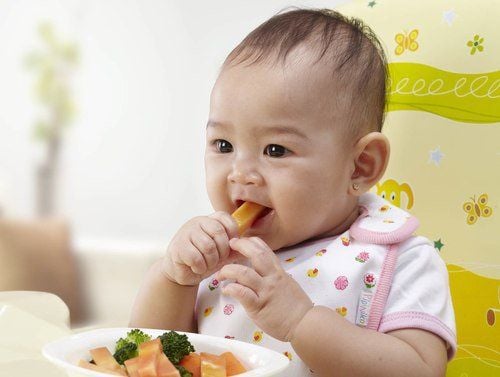This is an automatically translated article.
The article was professionally consulted with Master, Doctor Ngo Thi Oanh - Pediatrician - Department of Pediatrics - Neonatology - Vinmec Ha Long International General Hospital.Practicing chewing reflex for babies is very essential when bringing many benefits to children. Most parents fear, when learning to eat, children may choke, cough, choke, vomit. However, this is very normal, parents should be equipped with basic knowledge to help recognize signs when a child is choking and how to handle it.
1. Why should children practice chewing reflexes?
Helping your baby to practice chewing reflexes will be very good for the process of baby's weaning. In the process of weaning, babies need to practice a few basic reflexes to serve their future eating. Chewing food is one of them, when they don't know how to chew food but just swallow it like when sucking milk, many babies will have symptoms of vomiting every time they eat a little thicker food. Therefore, let's refer to the following ways to help your baby learn to chew food more easily and effectively.2. Children's reflexes when eating solid foods and how to handle them
The gag reflex The gag reflex is a very useful and safe reflex for children to handle large, very large, inappropriate foods. Oats help keep those foods out of the airways and prevent choking.In infants from 6 months to under 12 months, the gagging reflex is activated at the tip of the tongue differently from adults at the base of the tongue, so the child will gag much more easily. Ọe is also a way for children to learn by themselves through eating. After a few gags, your baby will learn to swallow only small, medium pieces of food, not large pieces to avoid choking.
In case the child shows signs of getting stuck in food, choking, coughing and trying to gag to push the food out, this proves that the baby can solve the problem on his own, parents should not be too worried. Calmly, calmly observe the child. Absolutely do not use your hands to pick up the child's throat or give the child water to drink, because these actions can cause the foreign body to go deeper into the airway, making it difficult for the foreign body to be removed, and the risk of choking is increased.
Chewing reflex Chewing is a combination of the tongue and the muscles in the oral cavity to knead and crush food to make it softer and smaller. Teeth are just one of the tools for chewing.
Babies from about 6-7 months old begin to have a chewing reflex, when most babies have not yet developed teeth or have only a few, so the best tool to practice chewing at this stage is their gums. little.
There are many people who think that baby gums are soft and weak, but in fact, this "stick" is extremely effective in handling a variety of rough foods no less than an adult with normal full teeth. Many parents have the habit of feeding their baby powder and porridge until they grow up and have enough new teeth to practice eating and chewing.
The baby's chewing reflex in the late stage has been significantly reduced, when the child gets older, the gag reflex will be pushed back to the base of the tongue like an adult, making the baby's risk of choking increased, which is dangerous for the child. , learning to eat raw food at this time will take both time and effort of parents.

Tập phản xạ nhai cho bé để hỗ trợ quá trình trẻ ăn dặm
3. How to practice chewing reflex for babies
A good chewing reflex will help the baby find it easier to eat solids, as well as help the baby increase the activity of the mouth muscles, limiting vomiting. Here are the basic steps to help your baby practice chewing reflex.Step 1:
Please practice giving your baby raw foods with tofu or soft, easy-to-swallow foods that your baby likes to eat such as potatoes, steamed sweet potatoes, fried eggs, mashed green beans. Mother started to feed her baby food by puree. Then come grind a little more and watch how your baby eats. If the baby is eating normally, there is no vomiting, then the next time it is more tangled, then proceed to 1/2 the size of the chopsticks so that the baby can chew on his own until he can swallow without vomiting. Mothers, please continue to do this patiently until the baby can eat the beans in any size that you roll and when put in the mouth, the baby has a chewy reflex, can swallow on his own. Step 2:
Mom, practice feeding your baby porridge. Porridge has a higher coarseness than beans, so it is still necessary to train the baby to have a chewing reflex. Every time she cooks porridge, the mother scoops out a spoonful of whole grain porridge, blending it more smoothly than the baby still eats a little. Then mix the porridge little by little into the baby's porridge bowl, then feed it to the baby and observe and notice how the baby reacts. If the baby shows signs of regurgitation, vomiting, then stop and return to practice feeding your baby with tofu. About 2 days later, practice mixing porridge again, mother must be patient until the baby can eat the ratio of 1/3, 2/3 and 1 single level. Because this step takes time for the baby to get used to, it can take months for the mother to train the baby's natural chewing reflex. By about 9 months, babies can eat stewed whole grain porridge, ground vegetables may have fiber and minced meat.
4. The secret to helping your baby practice quick chewing reflex
4.1 Time to help babies learn to chew Many mothers think that babies must have teeth to be able to chew, but this is not the case, even with the method of self-directed weaning (Baby Led Weaning (BLW) from 6 months old, Parents let children recognize food and let children chew and hold food by themselves. Helps babies have early chewing reflexes from soft, well-cooked foods that gradually increase in difficulty so that children learn to eat better.With traditional weaning methods, children can chew on their own from about 8 - 10 months old, so, right from the beginning of weaning (5.5 - 6 months), parents should let children observe. Adults chew by letting them eat with their parents, let children watch their parents practice chewing early and after the weaning period introduce foods for children to chew well.
4.2 Parents chew as an example for children to practice chewing Children have very good imitation ability, so, in order for children to learn how to chew, parents need to show their children that parents chew food often. After observing, the baby will gradually form the habit of chewing and practicing them.
However, in order for children to observe the food their parents chew, parents need to clearly divide the foods, to avoid mixing them all together or changing the food structure too quickly. For example, parents often eat green vegetables but constantly switch to cauliflower or carrots, this will cause children not to have time to shape the object that parents are chewing, not knowing what to chew properly, causing confusion. food perception in children.
4.3 Letting your baby handle food on his own
The way for a baby to learn to chew is not to feed the baby, but to let the baby hold the food and put it in his mouth. When in contact with food, the baby will easily recognize the hardness and softness of the food to adjust the mouth such as opening wider, chewing stronger... Before letting the baby chew on his own, parents can eat first to model, then encourage the child to follow along so that the child remembers the times you chewed like.
The first time children learn to chew is a very difficult period, because children are just getting used to it and children are too young to know what to do, they can only apply from imitation. Learning to chew for your baby needs to increase the difficulty of the food and change the structure of the food so that the baby learns to chew more dishes.

Cha mẹ có thể tập phản xạ nhai cho bé ngay từ khi bé bắt đầu ăn dặm
5. Common mistakes when teaching children to chew
A few typical mistakes when teaching babies to chew include:The notion that children without teeth cannot chew is a mistake. Babies can chew soft foods with their gums and swallow them easily. Feed the child without guiding the child to chew through the lessons by imitating parents so the child will not be able to chew properly, but often spit or spit the food. Parents think that letting children learn to chew with finely pureed porridge is completely wrong. Clear objects are needed for children to perceive and practice chewing on them. With fine foods, the only difference between milk and milk is that it is thicker, so children will not need to chew and still swallow food easily. Above are some useful information to help parents more easily practice chewing reflex for babies. If you have any questions, please contact the experts immediately for support.
Please dial HOTLINE for more information or register for an appointment HERE. Download MyVinmec app to make appointments faster and to manage your bookings easily.













